
The Boidae, commonly known as boas or boids, are a family of nonvenomous snakes primarily found in the Americas, as well as Africa, Europe, Asia, and some Pacific islands. Boas include some of the world's largest snakes, with the green anaconda of South America being the heaviest and second-longest snake known; in general, adults are medium to large in size, with females usually larger than the males. Six subfamilies comprising 15 genera and 54 species are currently recognized.

Boa is a genus of boas found in Mexico, the Caribbean, and Central and South America. Five extant species, and one extinct, are currently recognized.

Garter snake is the common name for small to medium-sized snakes belonging to the genus Thamnophis in the family Colubridae. Native to North and Central America, species in the genus Thamnophis can be found in all of the lower 48 United States, and nearly all of the Canadian provinces south of the Northwest Territories and Nunavut—with the exception of Prince Edward Island and Newfoundland and Labrador. They are found from the subarctic plains of west-central Canada east through Ontario and Quebec; from the Maritime Provinces and south to Florida, across the southern and central U.S. into the arid regions of the southwest and México, Guatemala and south to the neotropics and Costa Rica.

Loxocemus bicolor, the sole member of the monotypic family Loxocemidae and commonly known as the Mexican python, Mexican burrowing python and Mexican burrowing snake, is a species of python-like snake found in Mexico and Central America. No subspecies are currently recognized. Analyses of DNA show that Loxocemus is most closely related to the true pythons and the sunbeam snakes.
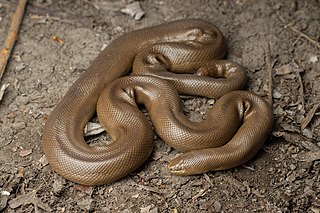
The rubber boa is a species of snake in the family Boidae and is native to western North America. It is sometimes known as the coastal rubber boa or the northern rubber boa and is not to be confused with the southern rubber boa.

The mountain slug snake, also known as the white-spotted slug snake, is a small, harmless species of snake that is rather common in South, South-East, and East Asia, and feeds on small invertebrates.
The common slug snake, Assam snail eater, Assam snail-eater snake, or montane slug-eating snake is a species of snake found in Northeast India, eastern Nepal, Bhutan, China, Myanmar, and Vietnam. Its type locality is "Naga Hills, Asám" (=Assam), India. It is also reported from north-eastern and south-eastern Bangladesh. The species was first described by Theodore Cantor in 1839.

Dipsas indica, also known as the neotropical snail-eater, is a snake species found in South America. It feeds on slugs and snails, which the snake can extract from their shells using its slender jaw.
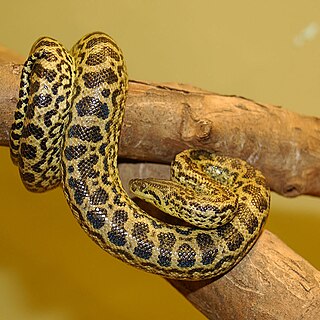
The yellow anaconda, also known as the Paraguayan anaconda, is a boa species endemic to southern South America. It is one of the largest snakes in the world but smaller than its close relative, the green anaconda. No subspecies are currently recognized. Like all boas and pythons, it is non-venomous and kills its prey by constriction.

The Cuban boa, also known as the Cuban tree boa and by locals as maja de Santa María, is a very large species of snake in the family Boidae. With lengths exceeding 5 m (16 ft) and a relatively heavy build, the Cuban boa is one of the largest snakes in the world. The species is native to Cuba and some nearby islands. No subspecies are currently recognized.

Iwasaki's snail-eater is a species of snake in the family Pareidae. The species is endemic to the Yaeyama Islands in the southern Ryukyu Islands, Japan.
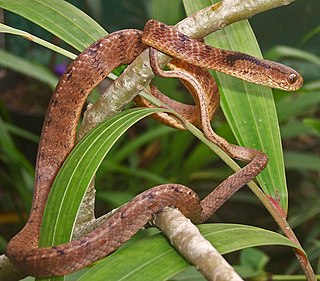
Pareas is a genus of Asian snakes in the family Pareidae. All species in the genus Pareas are harmless to humans.

The Alethinophidia are an infraorder of snakes that includes all snakes other than blind snakes and thread snakes. Snakes have long been grouped into families within Alethinophidia based on their morphology, especially that of their teeth. More modern phylogenetic hypotheses using genetic data support the recognition of 19 extant families, although the taxonomy of alethinophidian snakes has long been debated, and ultimately the decision whether to assign a particular clade to a particular Linnaean rank is arbitrary.
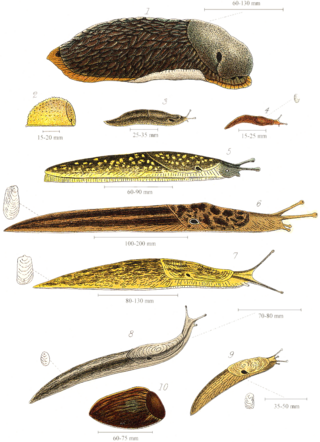
Slug, or land slug, is a common name for any apparently shell-less terrestrial gastropod mollusc. The word slug is also often used as part of the common name of any gastropod mollusc that has no shell, a very reduced shell, or only a small internal shell, particularly sea slugs and semi slugs.

Storeria occipitomaculata, commonly known as the redbelly snake or the red-bellied snake, is a species of harmless snake in the family Colubridae. The species is native to North America.

Charina umbratica, known commonly as the southern rubber boa, is a species of snake in the family Boidae. The species is endemic to the United States, in southern California.
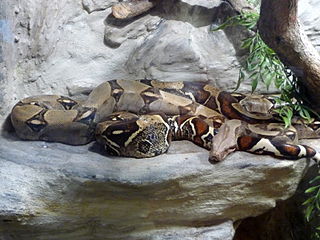
The boa constrictor, also known as the common boa, is a species of large, non-venomous, heavy-bodied snake that is frequently kept and bred in captivity. The boa constrictor is a member of the family Boidae. The species is native to tropical South America. A staple of private collections and public displays, its color pattern is highly variable yet distinctive. Four subspecies are recognized. This article focuses on the species Boa constrictor as a whole, and on the nominate subspecies B. c. constrictor.
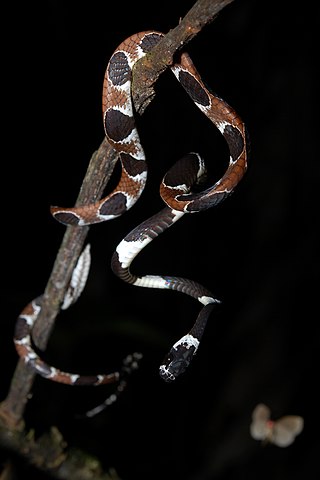
Catesby's snail-eater, also commonly known as Catesby's snail sucker, is a nocturnal species of nonvenomous snake in the family Colubridae. The species is native to northern South America.

The keeled slug-eating snake is a species of snake in the family Pareidae. It is relatively widespread in Southeast Asia, from southern China (Yunnan) to Burma and Indochina to the Malay Archipelago. Two subspecies are recognized: P. c. carinatus and P. c. unicolor, the latter being confined to Cambodia.
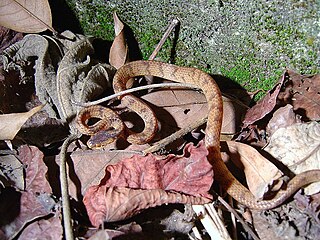
Formosa slug snake or Taiwan slug snake is a species of non-venomous snake in the family Pareatidae. It is endemic to Taiwan.



















